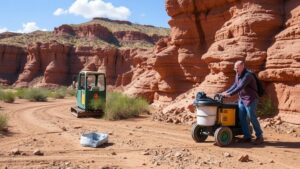Identifying Stream Layers With High Gold Content Using Simple Soil Testing
Identifying Stream Layers With High Gold Content Using Simple Soil Testing
The search for gold continues to intrigue and motivate prospectors, hobbyists, and researchers alike. Understanding soil layers that potentially contain high gold content is vital for efficient exploration. This article will provide a comprehensive overview of how simple soil testing could aid in identifying these layers, supported by practical examples and methodologies.
The Importance of Soil Testing in Gold Prospecting
Soil testing serves a crucial role in gold exploration, offering insights into the geological conditions of stream beds and surrounding areas. By analyzing soil composition, researchers can locate areas with higher probabilities of gold presence. According to the United States Geological Survey (USGS), around 10% of the deposits in the western U.S. could be economically viable, which emphasizes the need for effective exploration methodologies.
Understanding Stream Dynamics and Gold Deposition
The transport and deposition of gold in streams are influenced by several dynamic factors, including water flow, sediment transport, and the topography of the riverbed. Gold, being dense and heavy, tends to settle in specific locations during sediment transport. Key areas to focus on include:
- Natural Pockets: Depressions or low points in the stream bed where gold may accumulate.
- Behind Boulders: Larger rocks can disrupt water flow, causing sediment – including gold – to collect behind them.
- On Bedrock Outcrops: Exposed bedrock areas can also serve as traps for heavier materials.
Simple Soil Testing Methods
Utilizing straightforward soil testing techniques can significantly enhance the prospecting process. Here are some effective methods to identify gold-rich layers within streams:
- Panning: This traditional method involves using a pan to sift through sediment. If gold is present, it will settle at the bottom of the pan.
- Soil Sampling Kits: Available commercially, these kits allow for the collection and analysis of soil samples to determine mineral content.
- DIY Testing: A simple DIY method involves creating a DIY sluice box to separate gold from sediment based on density.
Case Study: Soil Testing in the Sierra Nevada
In the Sierra Nevada region, a group of amateur prospectors utilized simple soil testing techniques to identify gold-bearing layers. They collected soil samples from various points across a stream known for historical gold deposits. The samples were analyzed for particle size, composition, and mineral content. Results indicated a significant concentration of gold in areas with finer sediments, leading to targeted excavation that yielded approximately 12 grams of gold in a single day.
Interpreting Soil Test Results
Understanding the data obtained from soil testing is crucial for successful gold prospecting. Here are some key factors to consider when interpreting results:
- Particle Size Distribution: Finer particles may indicate areas of significant gold concentration since these are often lighter and carried upstream.
- Mineral Association: Identifying minerals that are commonly found with gold, such as quartz or iron pyrites, can enhance targeted efforts.
- Depth of Layers: Knowing the depth at which gold-rich layers occur can optimize excavation strategies.
Addressing Common Concerns
Prospectors may face several concerns regarding soil testing and gold identification:
- Accuracy of Results: Conducting multiple tests across different locations can improve accuracy.
- Environmental Impact: It is essential to follow local regulations and best practices to minimize environmental damage.
- Cost of Equipment: Many simple testing methods can be conducted with minimal investment, making them accessible to amateur prospectors.
Actionable Takeaways
Identifying stream layers with high gold content through simple soil testing can dramatically improve the efficiency of prospecting efforts. Key actions include:
- Conduct soil sampling at various depths and locations along streams.
- Use basic methods like panning and DIY sluice boxes for immediate results.
- Analyze soil composition and correlate with geological data to find promising areas.
By applying these techniques, aspiring gold prospectors can enhance their chances of uncovering valuable gold deposits while also gaining a deeper understanding of their local geology.
